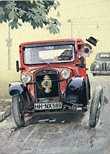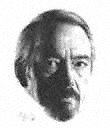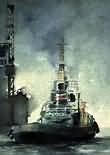Bruno Bergner

Bruno Bergner (* December 5, 1923 in Łódź , Poland as Bruno Gurski ; † June 2, 1995 in Hamburg ) was a German freelance commercial artist , draftsman and painter .
life and work
Growing up in the weaving city of Łódź (see also History of the City of Łódź: Rise to the Manchester of Poland ), he and his family were obliged to Germanize their names ex officio as members of the German minority at the end of 1939 . In 1941 Bruno Bergner joined the Reich Labor Service on the island of Texel . The ensuing period in the Wehrmacht took him from Freistadt as a tank destroyer to the Balkans, Normandy, the hospital (where he met his future wife) and back to Austria. From there he was taken prisoner by the Soviets in Dnepropetrovsk in May 1945 , from which he was only released in 1949.
In the camp he received his first artistic training in drawing and painting from a camp comrade, his first “public works” were illustrations on the prisoner-of-war mail to his mother and brother. He found both of them in 1949 in Armstorf / Langes Moor , whose foggy mood would influence many of his later watercolors. Excursions to Worpswede and the Teufelsmoor took place from here. Artistic commissioned work in oil and gouache provided the first wages and bread, followed by exercises in red chalk and pastel chalk .
The move to Hamburg and subsequent marriage in the early 1950s brought him to the studio of the illustrator Carl Busse , who at the time worked for NITAG AG, among others . Here he learned his profession as a graphic artist and in the following years taught himself all other techniques as an autodidact . He worked on the reference work OMNIBUS and for NITAG and got to know the advertising manager of NITAG and later Gasolin , Heinz Restorff. In 1956 he set up his own studio and became a member of the Association of German Commercial Graphics (BDG). In the 1960s Bergner co-founded the graphic design studios (gds), a community of independent studios for better and more comprehensive training of their graphic design students, as well as a member of the International Center for the Typographic Arts (ICTA).
In addition to airbrushing for Tesa , from 1956 until the takeover by Aral in 1971, as a freelance graphic artist , he painted and drew all the well-known gasoline illustrations and cartoons, for example in the 8 different gasoline tips, the driver's man with his slogan “Mein Petrol - Gasolin ”as well as many large-format advertisements in Indian ink with its blue pen ( pointed pen ). During this time he created many free artistic works in oil (which he gave up again in the early 1960s), watercolor , gouache, ink and airbrush. Since that time it has been included in Kürschner's graphic artist manual . Bruno Bergner was inspired by the work of Norman Rockwell and cartoons in The New Yorker .
At the beginning of the 1970s, Bergner received the call of the newly founded University of Applied Sciences Würzburg-Schweinfurt to establish the chair for design . Since he did not accept him, work for Texaco , BP , Beiersdorf and Rotring, among others, provided support for the family in the 1970s . In many landscape and maritime pictures (see also watercolor "Pamir" in the article Pamir (ship) ) he refined and perfected his watercolor technique (mainly wet-on-wet technique ), in addition, he created works in ink, chalk and charcoal . In his watercolors, Bruno Bergner captured the most diverse light impressions that he encountered in the course of his life, from the Balkans, the Teufelsmoor, Lüneburg Heath, the lake near Sylt to everyday experience in the Hamburg harbor.
In the 1980s, Heinrich Bauer Verlag became the largest customer. In addition to the Airbrush was squirrel hair -Brushes the defining working tool whether with watercolor or colored inks. True to his motto “Profession comes from calling”, Bruno Bergner could still be found in the studio every day until shortly before his death in 1995, in order to put his thoughts on paper with colors. Bergner was buried in the Ohlsdorf cemetery, as was his wife later.
Many of the later works are still in his estate today. Some of his original automotive works are exhibited in the Hamburg Museum Prototyp . The artistic work is continued in Hamburg by the younger of the two sons, Klaus Bergner (* 1961).
Works
- 50 tips for drivers , Deutsche Gasolin-Nitag AG, Hanover 1957; Paul W. Piehler (Ed.); Paul W. Piehler, Heinz Restorff (editor); Bruno Bergner, Hamburg (cover and drawings)
- 50 tour tips for drivers , Deutsche Gasolin-Nitag AG, Hanover 1958; Paul W. Piehler (Ed.); Heinz Restorff, Wilhelm Wißmüller (editor); Bruno Bergner, Hamburg (cover and drawings)
- 50 Tour Tips II for drivers , Deutsche Gasolin-Nitag AG, Hanover 1959; Paul W. Piehler (Ed.); Heinz Restorff, Wilhelm Wißmüller (editor); Bruno Bergner, Hamburg (cover and drawings)
- 50 tips for tractor drivers , Deutsche Gasolin-Nitag AG, Hanover 1959; Paul W. Piehler (Ed.); Heinz Restorff, Herbert Hardt (editor); Bruno Bergner, Hamburg (cover and drawings)
- 50 gasoline tips at war with paragraphs , Deutsche Gasolin-Nitag AG, Hanover 1960; Paul W. Piehler (Ed.); Heinz Restorff (editor); Bruno Bergner, Hamburg (cover and drawings)
- Gasolin-Tips Sights , Deutsche Gasolin-Nitag AG, Hannover 1961; Paul W. Piehler (Ed.); Heinz Restorff (editor); Bruno Bergner, Hamburg (cover and drawings)
- Gasolin-Tips Through German cities with open eyes , Deutsche Gasolin-Nitag AG, Hanover 1962; Paul W. Piehler (Ed.); Heinz Restorff (editor); Bruno Bergner, Hamburg (cover and drawings)
- Gasolin-Tips car guide for rest and travel , Deutsche Gasolin-Nitag AG, Hanover 1963; Paul W. Piehler (Ed.); Heinz Restorff (editor); Bruno Bergner, Hamburg (cover and drawings)
literature
- Ulrich Biene: Gasolin: Take your time - and not your life. (= Moving Times , Volume 26) Delius Klasing, Bielefeld 2018, ISBN 978-3667112460 .
- Sylvia Lott: Bruno Bergner: The man behind the gasoline man . In: Auto Bild Klassik, No. 8, August 2011, pp. 56–59. ( Online version ; PDF; 1.0 MB).
- Conrad Bauer-Schlichtegroll: Car dreams of the 1960s. In: Hamburger Abendblatt. 19./20. April 2008 (with an excerpt from a large pointillist advertisement for Gasolin).
- Bernd Polster : Super or normal. Gas stations - story of a modern myth. DuMont, Cologne, 1996. ISBN 3-7701-3516-4 .
- Charlotte Fergg-Frowein (ed.): Kürschner's graphic artist manual. Germany, Austria, Switzerland. Graphic artists, illustrators, caricaturists, commercial artists, typographers, book designers. de Gruyter, Berlin 1967 (2nd, expanded edition), ISBN 3-1100-0937-4 .
Web links
- Literature by and about Bruno Bergner in the catalog of the German National Library
- CV and selected works by Bruno Bergner
| personal data | |
|---|---|
| SURNAME | Bergner, Bruno |
| ALTERNATIVE NAMES | Gurski, Bruno (maiden name changed ex officio in 1940) |
| BRIEF DESCRIPTION | German commercial artist, painter, draftsman |
| DATE OF BIRTH | December 5, 1923 |
| PLACE OF BIRTH | Łódź , Poland |
| DATE OF DEATH | June 2, 1995 |
| Place of death | Hamburg |



